Search Result
Results for "
amino acid sequences
" in MedChemExpress (MCE) Product Catalog:
1
Biochemical Assay Reagents
2
Isotope-Labeled Compounds
| Cat. No. |
Product Name |
Target |
Research Areas |
Chemical Structure |
-
- HY-P1310
-
-
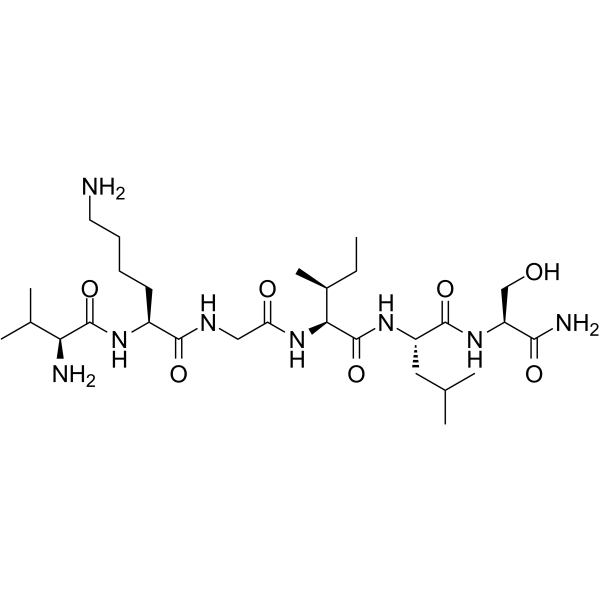
-
- HY-117695
-
AQC
2 Publications Verification
6-aminoquinolyl-N-hydroxysccinimidyl carbamate
|
Fluorescent Dye
|
Others
|
|
AQC (6-Aminoquinolyl-N-hydroxysccinimidyl carbamate) is a reagent used for amino acid or protein sequence analysis by HPLC with fluorescence detection. AQC reacts with primary and secondary amino acids to yield fluorescent derivates, allowing amino acid detection at under-picomolar levels .
|
-

-
- HY-P1310A
-
-
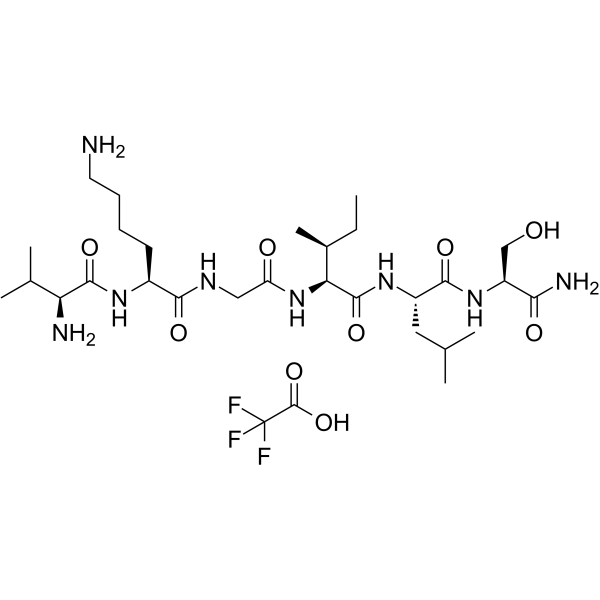
-
- HY-101877
-
|
(3S,4S)-Statine; (S,S)-Statine
|
Others
|
Endocrinology
|
|
Statine is an unusual amino acid that occurs twice in the sequence of pepstatin, a protease inhibitor that is active against pepsin and other acid proteases.
|
-

-
- HY-148217
-
|
|
Others
|
Others
|
|
DB02307 is a dipeptide that contains a sequence of two alpha-amino acids joined by a peptide bond .
|
-

-
- HY-108837
-
|
|
Others
|
Metabolic Disease
|
|
Agalsidase alfa has an amino acid sequence identical to that of native α-galactosidase A. Agalsidase alfa can be used for Fabry disease research .
|
-

-
- HY-P0064
-
|
|
|
|
|
Palmitoyl Tetrapeptide-3 is a synthetic peptide, corrspending to 341-344 amino acid sequence
of IgG human H-chain, with phagocytosis stimulating activity .
|
-
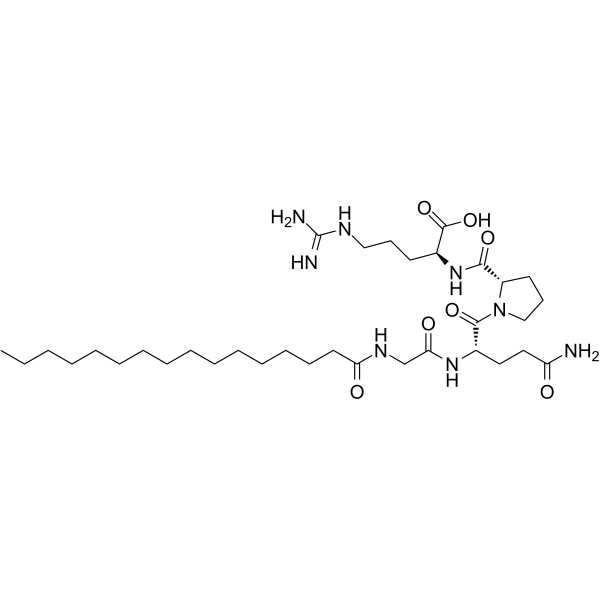
-
- HY-P3523
-
|
|
Integrin
|
Others
|
|
KGDS is synthetic peptides, targeting integrin GPIIb-IIIa located on the membrane of human activated platelets. Amino acid sequence: Lys-Gly-Asp-Ser .
|
-

-
- HY-P2162
-
|
|
Myosin
|
Cancer
|
|
Kemptamide, a 13 amino acid fragment with a sequence corresponding to residues 11-23 of gizzard light chain. Kemptamide is a peptide substrate of myosin light-chain kinase (MLCK) .
|
-
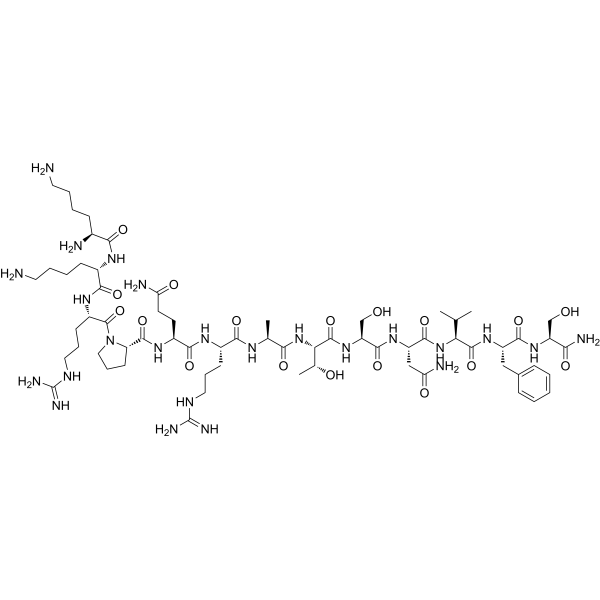
-
- HY-135900
-
|
|
ADC Cytotoxin
Bacterial
|
Cancer
|
|
Aniline-MPB-amino-C3-PBD is a cytotoxic agent comprised non-alkylating group. Aniline-MPB-amino-C3-PBD is a sequence-selective DNA minor-groove binding agent. Aniline-MPB-amino-C3-PBD acts as the payload for ADCs. Antimicrobial activity .
|
-
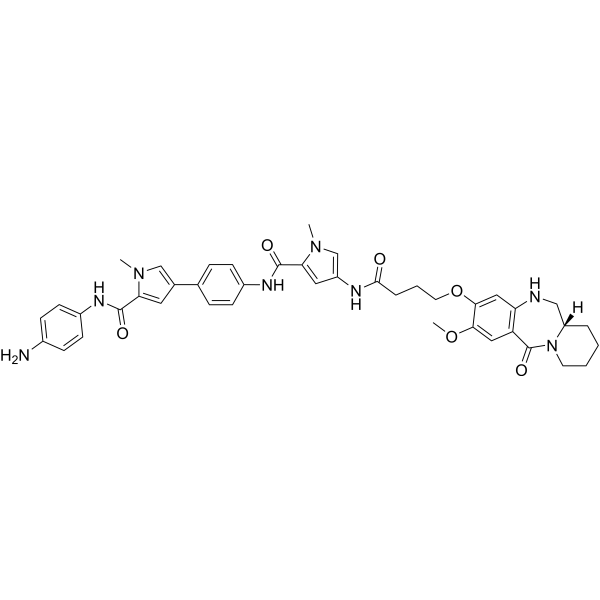
-
- HY-P3581
-
|
|
Potassium Channel
|
Neurological Disease
|
|
PE 22-28 is a TREK-1 inhibitor with IC50 value of 0.12 nM. PE 22-28 also is a 7 amino-acid peptide that is used as a core sequence for preparing analogs by chemical modifications and also by substitution of amino-acids. PE 22-28 can be used for the research of depression .
|
-
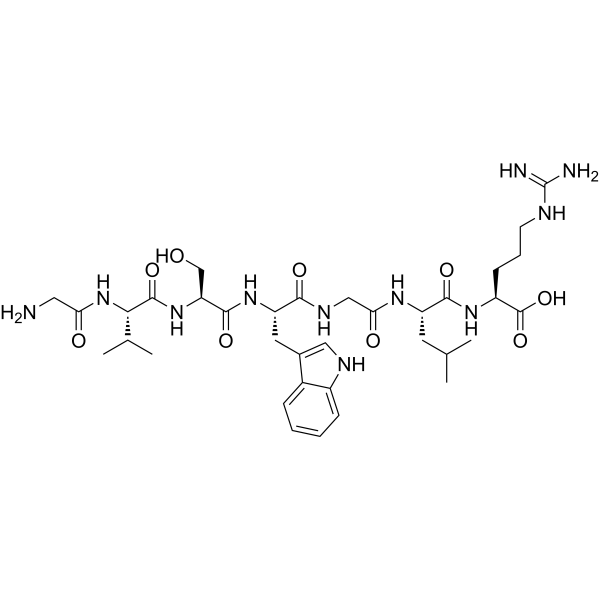
-
- HY-P5483
-
|
|
Bacterial
|
Others
|
|
Retro-indolicidin is a biological active peptide. (Reverse peptide of indolicidin (Rev4) is a 13-amino acid residue peptide based on the sequence of indolicidin. Indolicidin, a member of the cathelicidin protein family, is a 13-amino acid residue cationic, antimicrobial peptide-amide isolated from the cytoplasmic granules of bovine neutrophils. The synthetic peptide Rev4 has been shown to possess strong antimicrobial as well as protease inhibitory activities in vitro.)
|
-
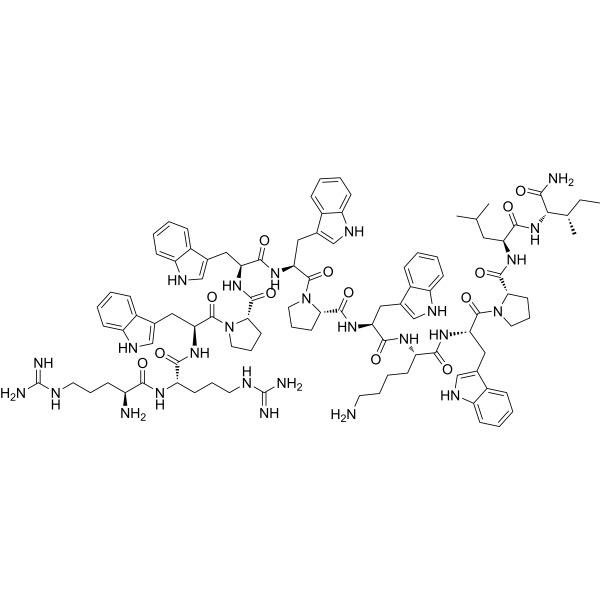
-
- HY-P2736
-
|
|
Endogenous Metabolite
|
Metabolic Disease
|
|
Amidases, a member of nitrilase superfamily, catalyzes the hydrolysis of an amide, leading to the formation of carboxylic acid and ammonia. Amidases contain a conserved stretch of approximately 130 amino acids known as the AS sequence, and play a role in important metabolic processes .
|
-
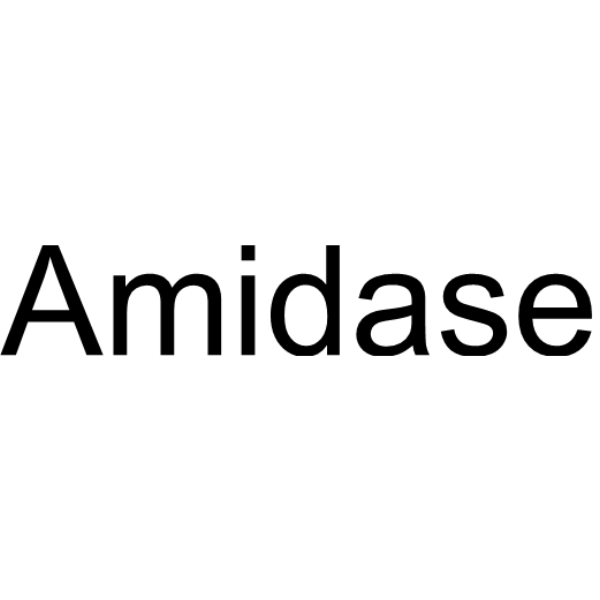
-
- HY-P7060
-
|
TPPT
|
iGluR
|
Neurological Disease
|
|
NT 13 (TPPT) is a tetrapeptide having the amino acid sequence L-threonyl-L-prolyl-L-prolyl-L-threonine amide. NT 13 is a partial N-methyl-D-aspartate receptor (NMDAR) agonist used in the study of depression, anxiety, and other related diseases.
|
-
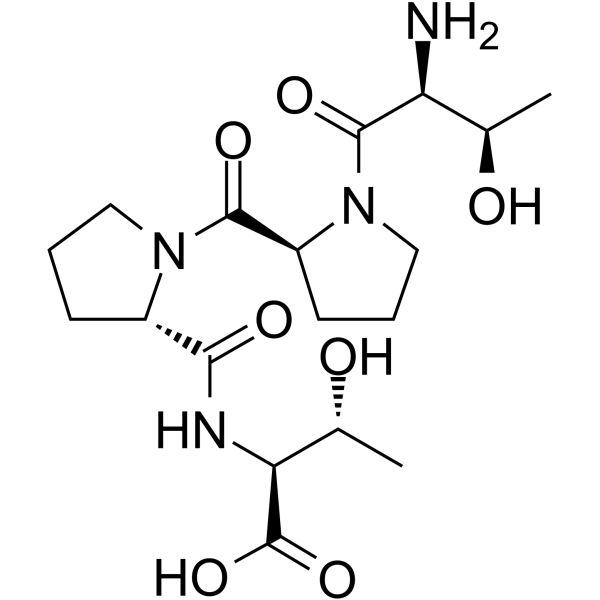
-
- HY-151678
-
|
|
ADC Linker
|
Others
|
|
N3-L-Lys(Mtt)-OH is a click chemistry reagent containing an azide group. N3-L-Lys(Mtt)-OH can introduce azide functions into the amino acid building block of peptide sequences at the N-terminal position.
|
-
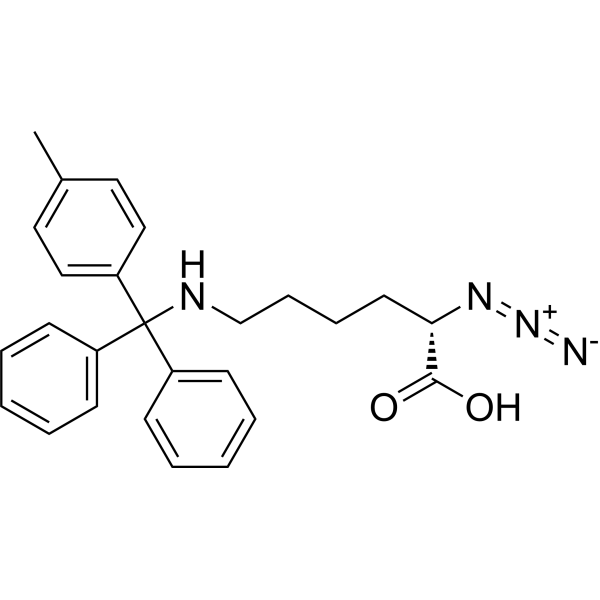
-
- HY-P3606
-
|
GAP (1-24), human
|
GnRH Receptor
|
Endocrinology
|
|
GnRH Associated Peptide (GAP) (1-24), human is the human gonadotropin-releasing hormone-associated peptide (GAP) 1-24 fragment (hGAP-1-24). GAP is joined to the luteinizing hormone-releasing hormone (LH-RH) sequence by a 3 amino acid processing site .
|
-

-
- HY-P5124
-
|
KLVFF
|
Amyloid-β
|
Neurological Disease
|
|
β-Amyloid peptide(16-20) is a amino acid sequences (KLVFF) of Amyloid-β (Abeta). β-Amyloid peptide(16-20) is an effective inhibitor of Abeta fibril formation, with RG-/-GR-NH2 residues added at N- and C-terminal ends to aid solubility) .
|
-
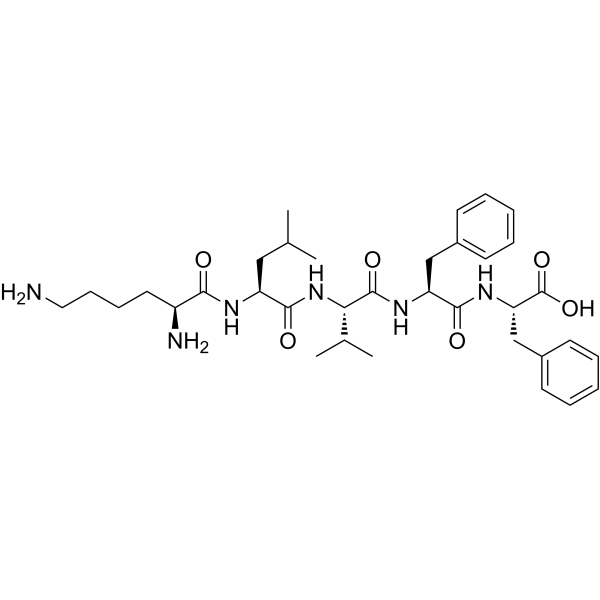
-
- HY-P5201S
-
|
|
Isotope-Labeled Compounds
|
Others
|
|
VTSEGAGLQLQK- 13C6, 15N2 is the 13C and 15N labeled VTSEGAGLQLQK. VTSEGAGLQLQK is an amino acid sequence in the C-terminal region of recombinant human alpha-acid glucosidase (rhGAA). VTSEGAGLQLQK can be used to bind anti-drug antibodies (ADA) in plasma and quantitatively analyze the therapeutic effect .
|
-
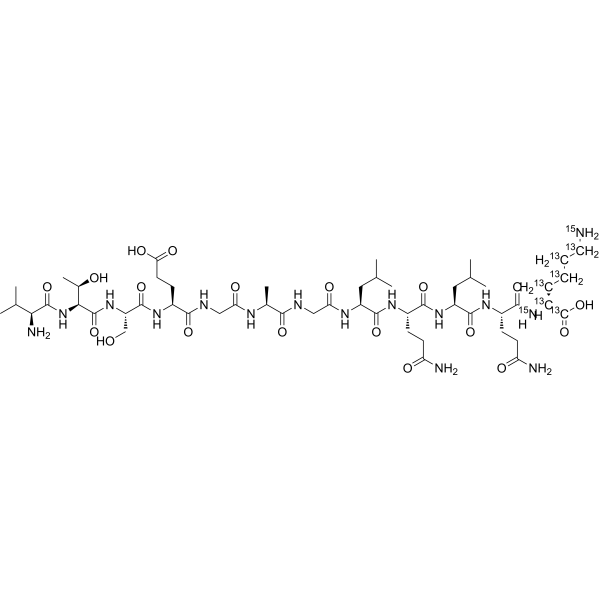
-
- HY-P5201S1
-
|
|
Isotope-Labeled Compounds
|
Others
|
|
VTSEGAGLQLQK- 13C6, 15N2 (TFA) is the 13C- and 15N-labeled VTSEGAGLQLQK. VTSEGAGLQLQK is an amino acid sequence in the C-terminal region of recombinant human alpha-acid glucosidase (rhGAA), which can be used to bind anti-drug antibodies in plasma and quantitatively analyze the therapeutic effect .
|
-
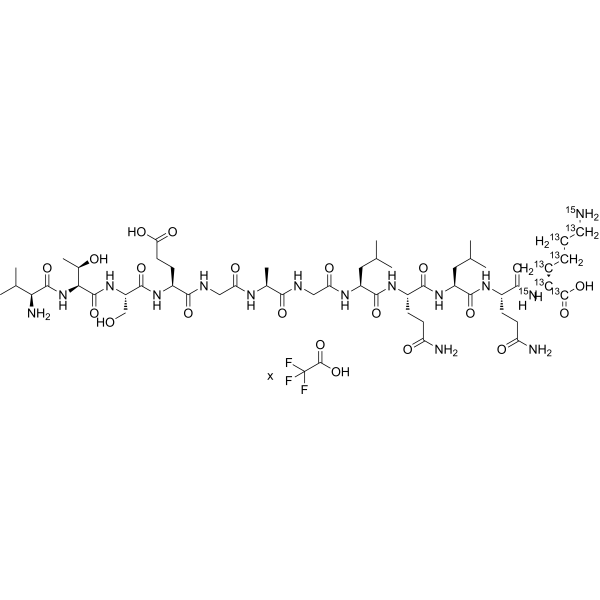
-
- HY-P5444
-
|
|
Bacterial
|
Others
|
|
Drosocin is a biological active peptide. (Drosocin is a 19-mer cationic antimicrobial peptide from Drosophila melanogaster. In Drosophila native drosocin carries a disaccharide moiety attached to a threonine residue in mid-chain position. This synthetic drosocin peptide of identical amino acid sequence without the disaccharide has an activity several times lower than the native compound.)
|
-
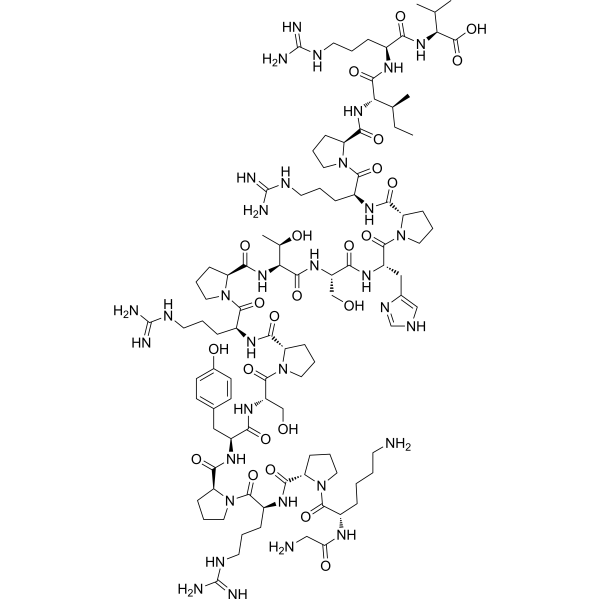
-
- HY-P5461
-
|
|
Bacterial
|
Others
|
|
CHRG01 is a biological active peptide. (CHRG01 is derived from human b-defensin 3 (hBD3) C-terminal amino acids 54 to 67, with all Cys residues substituted with Ser. This substitution removes all disulfide bond linkages within the sequence. CHRG01, like hBD3, displays electrostatic-dependent antimicrobial properties.)
|
-
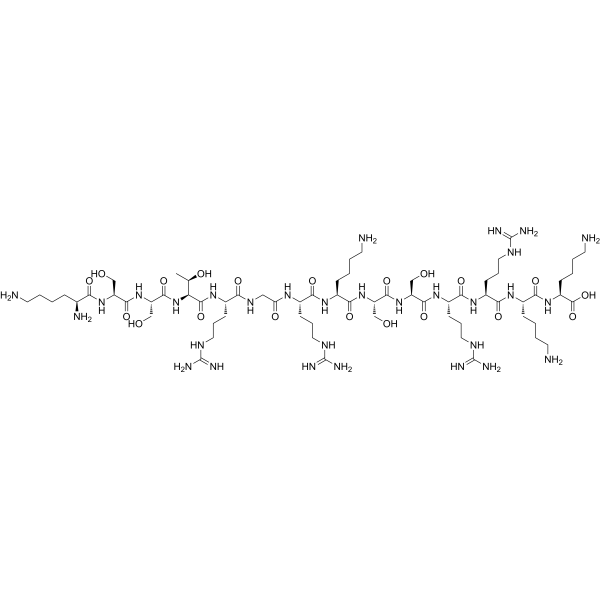
-
- HY-P5395
-
|
|
HIV
|
Others
|
|
TAT-GluR23A Fusion Peptide is a biological active peptide. (This is the GluR23A sequence, a control inactive peptide used as a mutant counterpart to glutamate receptor endocytosis inhibitor (GluR23Y), connected to an 11 amino acid cell permeable HIV Trans-Activator of Transcription (TAT) protein transduction domain (PTD). GluR23A is derived from GluR23Y amino acids 869 to 877, with Ala substituted for Tyr, and thus lacking essential phosphorylation sites.Control peptide of HY-P2259)
|
-

-
- HY-P3605
-
|
GAP (25-53), human
|
GnRH Receptor
|
Endocrinology
|
|
GnRH Associated Peptide (GAP) (25-53), human is the human gonadotropin-releasing hormone-associated peptide (GAP) 25-53 fragment (hGAP-25-53), can be used as immunogen to generate antiseras including MC-1, MC-2, and MC-3. GAP is joined to the luteinizing hormone-releasing hormone (LH-RH) sequence by a 3 amino acid processing site .
|
-

-
- HY-P3726
-
|
|
Integrin
|
Inflammation/Immunology
Cancer
|
|
Lys-Gln-Ala-Gly-Asp-Val (KQAGDV) is the six most carboxyl-terminal amino acids in the fibrinogen γ-chain sequence. Lys-Gln-Ala-Gly-Asp-Val is a cell adhesion peptide which is mediated through the α2bβ3 integrin. Lys-Gln-Ala-Gly-Asp-Val is a potent adhesion ligand for smooth muscle cells (SMCs) .
|
-

-
- HY-P5455
-
|
|
LIM Kinase (LIMK)
|
Others
|
|
S3 Fragment is a biological active peptide. (This peptide contains the unique amino-terminal phosphorylation site of Xenopus ADF/cofilin, the LIM kinase (LIMK) phosphorylation site. LIMK1 is a key regulator of the actin cytoskeleton through its phosphorylation of ADF/cofilin at serine-3 for inactivation. This peptide is a fragment of the S3 peptide containing the serine-3 sequence of ADF/cofilin that has been widely used as an effective competitive inhibitor of LIMK1.)
|
-

-
- HY-151780
-
|
|
ADC Linker
|
Others
|
|
Fmoc-L-Dap(Pentynoyl)-OH is a click chemistry reagent containing an azide group. Fmoc-L-Dap(Pentynoyl)-OH serves as an amino acid building block for introducing alkyne functions into peptide sequences by standard Fmoc/tBu protocols. The alkyne residue can be engaged for copper catalyzed click reaction with organic azides or with tetrazines for copper-free conjugations . Fmoc-L-Dap(Pentynoyl)-OH is a click chemistry reagent, it contains an Alkyne group and can undergo copper-catalyzed azide-alkyne cycloaddition (CuAAc) with molecules containing Azide groups.
|
-
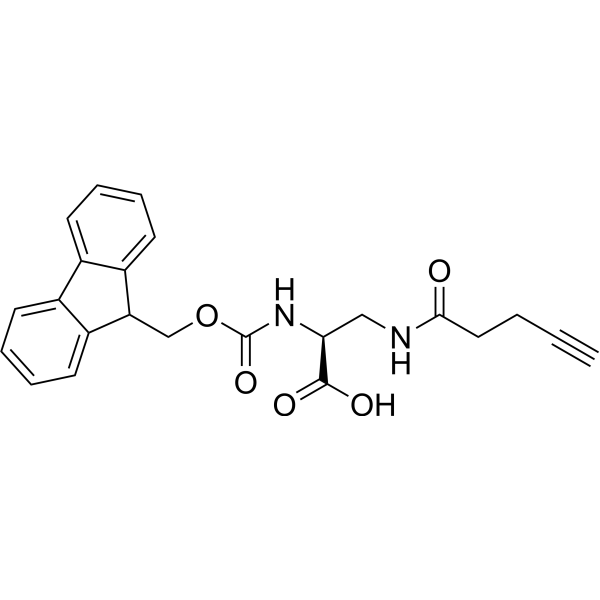
| Cat. No. |
Product Name |
Type |
-
- HY-117695
-
AQC
2 Publications Verification
6-aminoquinolyl-N-hydroxysccinimidyl carbamate
|
Fluorescent Dyes/Probes
|
|
AQC (6-Aminoquinolyl-N-hydroxysccinimidyl carbamate) is a reagent used for amino acid or protein sequence analysis by HPLC with fluorescence detection. AQC reacts with primary and secondary amino acids to yield fluorescent derivates, allowing amino acid detection at under-picomolar levels .
|
| Cat. No. |
Product Name |
Type |
-
- HY-P2736
-
|
|
Biochemical Assay Reagents
|
|
Amidases, a member of nitrilase superfamily, catalyzes the hydrolysis of an amide, leading to the formation of carboxylic acid and ammonia. Amidases contain a conserved stretch of approximately 130 amino acids known as the AS sequence, and play a role in important metabolic processes .
|
| Cat. No. |
Product Name |
Target |
Research Area |
-
- HY-P3460A
-
-
- HY-P1310
-
-
- HY-P3460
-
-
- HY-P1310A
-
-
- HY-P3051
-
|
|
Peptides
|
Inflammation/Immunology
|
|
CKS-17 is a synthetic retroviral envelope peptide. CKS-17 has the highly conserved amino acid sequences occurring within the transmembrane envelope protein of many animal and human retroviruses. CKS-17 acts as an immunomodulatory epitope and exhibits suppressive properties for numerous immune functions .
|
-
- HY-P3534
-
|
|
Peptides
|
Cancer
|
|
EILDV (human, bovine, rat) is an analogue of the active pentapeptide. EILDV (human, bovine, rat) has active tripeptide amino acid sequence LDV that is conserved in human, bovine, rat. EILDV (human, bovine, rat) can be used for the research of cell adhesion .
|
-
- HY-P5217
-
|
|
Peptides
|
Others
|
|
CSTSMLKAC (peptide 2) is a cyclic 9 amino acid sequence that mimics endogenous peptide sequences. CSTSMLKAC homes to cardiomyocytes in the ischemic myocardium .
|
-
- HY-P2517
-
|
|
Peptides
|
Others
|
|
Scrambled TRAP Fragment is a scrambled sequence of TRAP Fragment. Scrambled TRAP Fragment with a random sequence of the amino acids that are the same as the active fragment. Scrambled TRAP Fragment usually used as a negative control.
|
-
- HY-P3526
-
|
|
Peptides
|
Others
|
|
YQEAFRRFFGPV is a short peptide sequence containing 12 amino acid residues with some emulsification ability
|
-
- HY-P1311
-
|
|
Peptides
|
Others
|
|
RLLFT-NH2 is a reversed amino acid sequence negative control peptide for TFLLR-NH2 .
|
-
- HY-P1311A
-
|
|
Peptides
|
Others
|
|
RLLFT-NH2 TFA is a reversed amino acid sequence negative control peptide for TFLLR-NH2 .
|
-
- HY-P5300
-
|
|
Peptides
|
Others
|
|
YNPCVMYL (Thioester: Cys4-Leu8) is a polypeptide chain of the YNPCVMYL sequence. The link between the fourth and eighth amino acids in the sequence has the properties of a thioester, which is formed between cysteine (Cys4) and leucine (Leu8).
|
-
- HY-P5300A
-
|
|
Peptides
|
Others
|
|
YNPCVMYL (Thioester: Cys4-Leu8) TFA is a polypeptide chain of the YNPCVMYL sequence. The link between the fourth and eighth amino acids in the sequence has the properties of a thioester, which is formed between cysteine (Cys4) and leucine (Leu8).
|
-
- HY-P2193
-
|
|
Peptides
|
Infection
|
|
TAT-amide is a cell penetrating peptide. Cell-penetrating peptides (CPPs) are short amino acid sequences able to enter different cells .
|
-
- HY-P2193A
-
|
|
Peptides
|
Infection
|
|
TAT-amide TFA is a cell penetrating peptide. Cell-penetrating peptides (CPPs) are short amino acid sequences able to enter different cells .
|
-
- HY-P3523
-
|
|
Integrin
|
Others
|
|
KGDS is synthetic peptides, targeting integrin GPIIb-IIIa located on the membrane of human activated platelets. Amino acid sequence: Lys-Gly-Asp-Ser .
|
-
- HY-P4749
-
|
|
Peptides
|
Neurological Disease
|
|
Prion Protein (106-126) (human) (scrambled) is a scrambled sequence of Prion Protein (106-126). Prion Protein (106-126) (human) (scrambled) with a random sequence of the amino acids that are the same as the active fragment. Prion Protein (106-126) (human) (scrambled) usually used as a negative control .
|
-
- HY-P1849
-
|
scJag-1
|
Peptides
|
Cardiovascular Disease
|
|
JAG-1, scrambled (scJag-1) is a scrambled sequence of JAG-1 (Jagged-1 protein). JAG-1, scrambled has a random sequence of the amino acids that are the same as the active fragment. JAG-1, scrambled is usually used as a negative control .
|
-
- HY-P2162
-
|
|
Myosin
|
Cancer
|
|
Kemptamide, a 13 amino acid fragment with a sequence corresponding to residues 11-23 of gizzard light chain. Kemptamide is a peptide substrate of myosin light-chain kinase (MLCK) .
|
-
- HY-P1849A
-
|
scJag-1 TFA
|
Peptides
|
Cardiovascular Disease
|
|
JAG-1, scrambled (scJag-1) TFA is a scrambled sequence of JAG-1 (Jagged-1 protein). JAG-1, scrambled TFA has a random sequence of the amino acids that are the same as the active fragment. JAG-1, scrambled TFA is usually used as a negative control .
|
-
- HY-P4807
-
|
Hez-PBAN
|
Peptides
|
Neurological Disease
|
|
Pheromone Biosynthesis Activating Neuropeptide (Helicoverpa assulta, Heliothis zea) (PBAN), a member of the PBAN/Pyrokinin neuropeptide family, characterized by a common amino acid sequence FXPRLamide motif in the C-terminus .
|
-
- HY-P4104
-
|
|
Peptides
|
Others
|
|
pVEC (Cadherin-5) is a cell-penetrating 18-amino acid-long peptide derived from the murine sequence of the cell adhesion molecule vascular endothelial cadherin. pVEC (Cadherin-5) is efficiently and rapidly taken up into cells, it can be used as a carrier peptide .
|
-
- HY-115379
-
|
|
Peptides
|
Cancer
|
|
Latromotide is a synthetic peptide with antineoplastic activity. It consists of 10 amino acids corresponding to amino acid residues 66-75 of the human kinesin-like protein KIF20A. Latromotide has a sequence of H-Lys-Val-Tyr-Leu-Arg-Val-Arg-Pro Leu-Leu-OH .
|
-
- HY-P3581
-
|
|
Potassium Channel
|
Neurological Disease
|
|
PE 22-28 is a TREK-1 inhibitor with IC50 value of 0.12 nM. PE 22-28 also is a 7 amino-acid peptide that is used as a core sequence for preparing analogs by chemical modifications and also by substitution of amino-acids. PE 22-28 can be used for the research of depression .
|
-
- HY-P5483
-
|
|
Bacterial
|
Others
|
|
Retro-indolicidin is a biological active peptide. (Reverse peptide of indolicidin (Rev4) is a 13-amino acid residue peptide based on the sequence of indolicidin. Indolicidin, a member of the cathelicidin protein family, is a 13-amino acid residue cationic, antimicrobial peptide-amide isolated from the cytoplasmic granules of bovine neutrophils. The synthetic peptide Rev4 has been shown to possess strong antimicrobial as well as protease inhibitory activities in vitro.)
|
-
- HY-P3211B
-
|
LR12-scr
|
Peptides
|
Inflammation/Immunology
|
|
Nangibotide scrambled peptide (LR12-scr) is a scrambled control peptide composed of the same amino acids from LR12 (Nangibotide; HY-P3211) but in a random sequence (YQDVELCETGED) .
|
-
- HY-P2736
-
|
|
Endogenous Metabolite
|
Metabolic Disease
|
|
Amidases, a member of nitrilase superfamily, catalyzes the hydrolysis of an amide, leading to the formation of carboxylic acid and ammonia. Amidases contain a conserved stretch of approximately 130 amino acids known as the AS sequence, and play a role in important metabolic processes .
|
-
- HY-P4796
-
|
Proglucagon (33-69)
|
Peptides
|
Metabolic Disease
|
|
Oxyntomodulin (human, mouse, rat) (Proglucagon (33-69)) is a product of the glucagon precursor. Oxyntomodulin (human, mouse, rat) contains the entire glucagon sequence plus a C-terminal octapeptide, comprising in total 37 amino acids.
|
-
- HY-P5499
-
|
|
Peptides
|
Others
|
|
CMV pp65(13-27) is a biological active peptide. (This peptide is derived from amino acid residues 13 to 27 of the 65k lower matrix phosphoprotein of the human cytomegalovirus. It contains a nine-amino-acid sequence (LGPISGHVL) that matches the consensus binding motif for a major histocompatibility complex H2-Dd T-cell epitope.)
|
-
- HY-P1781
-
|
|
Peptides
|
Cancer
|
|
Peptide C105Y, a synthetic and cell-penetrating peptide based on the amino acid sequence corresponding to residues 359-374 of α1-antitrypsin, enhances gene expression from DNA nanoparticles .
|
-
- HY-P7060
-
|
TPPT
|
iGluR
|
Neurological Disease
|
|
NT 13 (TPPT) is a tetrapeptide having the amino acid sequence L-threonyl-L-prolyl-L-prolyl-L-threonine amide. NT 13 is a partial N-methyl-D-aspartate receptor (NMDAR) agonist used in the study of depression, anxiety, and other related diseases.
|
-
- HY-P1781A
-
|
|
Peptides
|
Cancer
|
|
Peptide C105Y TFA, a synthetic and cell-penetrating peptide based on the amino acid sequence corresponding to residues 359-374 of α1-antitrypsin, enhances gene expression from DNA nanoparticles .
|
-
- HY-P3541
-
|
MBP8298
|
Peptides
|
Neurological Disease
Inflammation/Immunology
|
|
Dirucotide (MBP8298) is a synthetic peptide that consists of 17 amino acids linked in a sequence identical to that of a portion of human myelin basic protein. Dirucotide can be used for the research in autoimmune disorder of the central nervous system, such as Multiple sclerosis (MS) .
|
-
- HY-P1798
-
|
|
Peptides
|
Cardiovascular Disease
|
|
Platelet Factor 4 (58-70), human, a peptide based on the amino acid sequence corresponding to residues 58-70 of platelet factor-4 (PF-4), contains the major heparin-binding domain, which is not sufficient for full antiangiogenic activity .
|
-
- HY-P3606
-
|
GAP (1-24), human
|
GnRH Receptor
|
Endocrinology
|
|
GnRH Associated Peptide (GAP) (1-24), human is the human gonadotropin-releasing hormone-associated peptide (GAP) 1-24 fragment (hGAP-1-24). GAP is joined to the luteinizing hormone-releasing hormone (LH-RH) sequence by a 3 amino acid processing site .
|
-
- HY-P5832
-
|
|
Peptides
|
Others
|
|
BMP2-derived peptide is a functional motif from positions 73 to 92 of the amino acid sequence of BMP-2. BMP2-derived peptide promotes osteogenic differentiation of bone marrow stromal cells (BMSCs) and enhances bone regeneration .
|
-
- HY-P5514
-
|
Amylin (22-27) [NMeG24, NMeI26], human (IAPP)
|
Peptides
|
Others
|
|
NF(N-Me)GA(N-Me)IL is a biological active peptide. (This amino acids 22 to 27 fragment is a modification of the human islet amyloid polypeptide hIAPP (NFGAIL) with N-methylation of the amide bonds at G24 and I26. The introduction of two N-methyl rests in the amyloid-core-containing sequence NFGAIL converts this amyloidogenic and cytotoxic sequence into non-amyloidogenic and non-cytotoxic peptide. The peptide is able to bind with high-affinity full-length hIAPP and to inhibit its fibrillogenesis.)
|
-
- HY-P3325
-
|
D-P8RI
|
Peptides
|
Inflammation/Immunology
|
|
P8RI (D-P8RI) is a biomimetic peptide of CD31 and a CD31 agonist. P8RI binds to the juxtamembrane amino acid sequence of the ectodomain of CD31, shows an immunosuppressive effect through restoration of the CD31 inhibitory pathway .
|
-
- HY-P5124
-
|
KLVFF
|
Amyloid-β
|
Neurological Disease
|
|
β-Amyloid peptide(16-20) is a amino acid sequences (KLVFF) of Amyloid-β (Abeta). β-Amyloid peptide(16-20) is an effective inhibitor of Abeta fibril formation, with RG-/-GR-NH2 residues added at N- and C-terminal ends to aid solubility) .
|
-
- HY-P5201S1
-
|
|
Isotope-Labeled Compounds
|
Others
|
|
VTSEGAGLQLQK- 13C6, 15N2 (TFA) is the 13C- and 15N-labeled VTSEGAGLQLQK. VTSEGAGLQLQK is an amino acid sequence in the C-terminal region of recombinant human alpha-acid glucosidase (rhGAA), which can be used to bind anti-drug antibodies in plasma and quantitatively analyze the therapeutic effect .
|
-
- HY-P5444
-
|
|
Bacterial
|
Others
|
|
Drosocin is a biological active peptide. (Drosocin is a 19-mer cationic antimicrobial peptide from Drosophila melanogaster. In Drosophila native drosocin carries a disaccharide moiety attached to a threonine residue in mid-chain position. This synthetic drosocin peptide of identical amino acid sequence without the disaccharide has an activity several times lower than the native compound.)
|
-
- HY-P5461
-
|
|
Bacterial
|
Others
|
|
CHRG01 is a biological active peptide. (CHRG01 is derived from human b-defensin 3 (hBD3) C-terminal amino acids 54 to 67, with all Cys residues substituted with Ser. This substitution removes all disulfide bond linkages within the sequence. CHRG01, like hBD3, displays electrostatic-dependent antimicrobial properties.)
|
-
- HY-P5395
-
|
|
HIV
|
Others
|
|
TAT-GluR23A Fusion Peptide is a biological active peptide. (This is the GluR23A sequence, a control inactive peptide used as a mutant counterpart to glutamate receptor endocytosis inhibitor (GluR23Y), connected to an 11 amino acid cell permeable HIV Trans-Activator of Transcription (TAT) protein transduction domain (PTD). GluR23A is derived from GluR23Y amino acids 869 to 877, with Ala substituted for Tyr, and thus lacking essential phosphorylation sites.Control peptide of HY-P2259)
|
-
- HY-P0306
-
|
Heparin Binding Peptide
|
Peptides
|
Cardiovascular Disease
|
|
Fibronectin Adhesion-promoting Peptide (Heparin Binding Peptide) is one of the heparin-binding amino acid sequences found in the carboxy-terminal heparin-binding domain of fibronectin. It promotes assembly of mesenchymal stem cell (MSC) spheroids into larger aggregates. Fibronectin Adhesion-promoting Peptide directly promotes the adhesion, spreading, and migration of endothelial cells by reacting with heparin binding domains of cells .
|
-
- HY-P0306A
-
|
Heparin Binding Peptide TFA
|
Peptides
|
Cardiovascular Disease
|
|
Fibronectin Adhesion-promoting Peptide (Heparin Binding Peptide) is one of the heparin-binding amino acid sequences found in the carboxy-terminal heparin-binding domain of fibronectin. It promotes assembly of mesenchymal stem cell (MSC) spheroids into larger aggregates. Fibronectin Adhesion-promoting Peptide directly promotes the adhesion, spreading, and migration of endothelial cells by reacting with heparin binding domains of cells .
|
-
- HY-P3605
-
|
GAP (25-53), human
|
GnRH Receptor
|
Endocrinology
|
|
GnRH Associated Peptide (GAP) (25-53), human is the human gonadotropin-releasing hormone-associated peptide (GAP) 25-53 fragment (hGAP-25-53), can be used as immunogen to generate antiseras including MC-1, MC-2, and MC-3. GAP is joined to the luteinizing hormone-releasing hormone (LH-RH) sequence by a 3 amino acid processing site .
|
-
- HY-P3726
-
|
|
Integrin
|
Inflammation/Immunology
Cancer
|
|
Lys-Gln-Ala-Gly-Asp-Val (KQAGDV) is the six most carboxyl-terminal amino acids in the fibrinogen γ-chain sequence. Lys-Gln-Ala-Gly-Asp-Val is a cell adhesion peptide which is mediated through the α2bβ3 integrin. Lys-Gln-Ala-Gly-Asp-Val is a potent adhesion ligand for smooth muscle cells (SMCs) .
|
-
- HY-P5472
-
|
|
Peptides
|
Others
|
|
Tumour-associated MUC1 epitope is a biological active peptide. (This sequence is the hallmark of MUC1 mucin. MUC1 is a highly glycosylated type I transmembrane glycoprotein with a unique extracellular domain consisting of a variable number of tandem repeats (VNTR) of this 20 amino acid peptide. It is overexpressed on the cell surface of many human adenocarcinomas and hematological malignancies, including multiple myeloma and B-cell lymphoma, making MUC1 broadly applicable target for immunotherapeutic strategies.)
|
-
- HY-P5455
-
|
|
LIM Kinase (LIMK)
|
Others
|
|
S3 Fragment is a biological active peptide. (This peptide contains the unique amino-terminal phosphorylation site of Xenopus ADF/cofilin, the LIM kinase (LIMK) phosphorylation site. LIMK1 is a key regulator of the actin cytoskeleton through its phosphorylation of ADF/cofilin at serine-3 for inactivation. This peptide is a fragment of the S3 peptide containing the serine-3 sequence of ADF/cofilin that has been widely used as an effective competitive inhibitor of LIMK1.)
|
-
- HY-P5479
-
|
|
Peptides
|
Others
|
|
EE epitope is a biological active peptide. (This peptide is a 314 to 319 amino acids fragment of the middle T antigen of mouse polymavirus. Glu-Glu epitope peptide is widely used as an epitope tag.Pyroglutamyl (pGlu) peptides may spontaneously form when either Glutamine (Q) or Glutamic acid (E) is located at the sequence N-terminus. The conversion of Q or E to pGlu is a natural occurrence and in general it is believed that the hydrophobic γ-lactam ring of pGlu may play a role in peptide stability against gastrointestinal proteases. Pyroglutamyl peptides are therefore considered a normal subset of such peptides and are included as part of the peptide purity during HPLC analysis.)
|
- HY-P5429
-
|
|
Peptides
|
Others
|
|
DNA-PK Substrate is a biological active peptide. (A substrate for DNA-dependent protein kinase (DNA-PK), phosphorylation. DNA-PK is essential for the repair of DNA double-strand breaks. This peptide corresponding to 11–24 amino acids of human p53 with threonine 18 and serine 20 changed to alanine is used as a substrate for the assay of DNA-PK activityPyroglutamyl (pGlu) peptides may spontaneously form when either Glutamine (Q) or Glutamic acid (E) is located at the sequence N-terminus. The conversion of Q or E to pGlu is a natural occurrence and in general it is believed that the hydrophobic γ-lactam ring of pGlu may play a role in peptide stability against gastrointestinal proteases. Pyroglutamyl peptides are therefore considered a normal subset of such peptides and are included as part of the peptide purity during HPLC analysis.)
|
- HY-P5502
-
|
|
Peptides
|
Others
|
|
Influenza NP (311-325) is a biological active peptide. (This peptide is amino acids 311 to 325 fragment of the influenza virus nucleoprotein (NP). This bona fide MHC class II restricted epitope from influenza virus was used to study the host immunoresponse during the infection. This peptide elicits the strongest gamma interferon (IFN-gamma) production in the intracellular cytokine assays. It does not stimulate CD8 T-cells in mice.Pyroglutamyl (pGlu) peptides may spontaneously form when either Glutamine (Q) or Glutamic acid (E) is located at the sequence N-terminus. The conversion of Q or E to pGlu is a natural occurrence and in general it is believed that the hydrophobic γ-lactam ring of pGlu may play a role in peptide stability against gastrointestinal proteases. Pyroglutamyl peptides are therefore considered a normal subset of such peptides and are included as part of the peptide purity during HPLC analysis.)
|
| Cat. No. |
Product Name |
Chemical Structure |
-
- HY-P5201S
-
|
|
|
VTSEGAGLQLQK- 13C6, 15N2 is the 13C and 15N labeled VTSEGAGLQLQK. VTSEGAGLQLQK is an amino acid sequence in the C-terminal region of recombinant human alpha-acid glucosidase (rhGAA). VTSEGAGLQLQK can be used to bind anti-drug antibodies (ADA) in plasma and quantitatively analyze the therapeutic effect .
|
-

-
- HY-P5201S1
-
|
|
|
VTSEGAGLQLQK- 13C6, 15N2 (TFA) is the 13C- and 15N-labeled VTSEGAGLQLQK. VTSEGAGLQLQK is an amino acid sequence in the C-terminal region of recombinant human alpha-acid glucosidase (rhGAA), which can be used to bind anti-drug antibodies in plasma and quantitatively analyze the therapeutic effect .
|
-

| Cat. No. |
Product Name |
|
Classification |
-
- HY-151678
-
|
|
|
Azide
|
|
N3-L-Lys(Mtt)-OH is a click chemistry reagent containing an azide group. N3-L-Lys(Mtt)-OH can introduce azide functions into the amino acid building block of peptide sequences at the N-terminal position.
|
-
- HY-151780
-
|
|
|
Alkynes
|
|
Fmoc-L-Dap(Pentynoyl)-OH is a click chemistry reagent containing an azide group. Fmoc-L-Dap(Pentynoyl)-OH serves as an amino acid building block for introducing alkyne functions into peptide sequences by standard Fmoc/tBu protocols. The alkyne residue can be engaged for copper catalyzed click reaction with organic azides or with tetrazines for copper-free conjugations . Fmoc-L-Dap(Pentynoyl)-OH is a click chemistry reagent, it contains an Alkyne group and can undergo copper-catalyzed azide-alkyne cycloaddition (CuAAc) with molecules containing Azide groups.
|
Your information is safe with us. * Required Fields.
Inquiry Information
- Product Name:
- Cat. No.:
- Quantity:
- MCE Japan Authorized Agent:


































